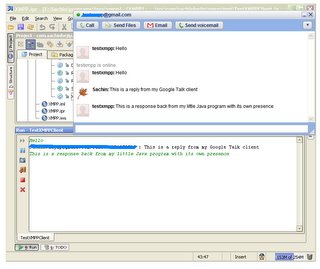Whenever I go through the Keyword Analysis page of Statcounter, which manages my blog web usage statistics for me, I see a bunch of Java questions which I can answer. However the page that people land on to never has the relevant answer to the query. With my recent Repetitive Stress Injury I am pretty much staying away from doing any more work than is required to help my hands heal faster. This is keeping me from working on my Google Talk programs. So, having nothing better to do I am going to try and answer some of the questions or searches that I saw coming to my blog.
Search Keywords: Java printStackTrace does not show line number
Happens if the classes that are part of the stack trace have not been compiled with the debugging option (-g) on. Here's the link for details on javac's options. The solution is to re-compile the classes with this option on and then recreate the exception. If it is not code you can build then there is not much you can do here unfortunately - you will have to analyze the code to figure out where it went wrong. Not having debug information while compiling usually also means that you won't get any local variable information while debugging in a JPDA debugger (to be complete precise that would mean that the -g:vars option has not been specified).
Search Keywords: how can i tell what caused a concurrentmodificationexception?
A ConcurrentModificationException happens if a java.util.Collection is modified while an Iterator is iterating over it. There are many ways you can end up doing this - I am going to try and list the situations that I believe are most common.
Disclaimer: Code snippets do not use generics which won't make any difference anyway.
1.] Listeners
Consider this listener interface -
XYZListener.java
1 public interface XYZListener {
2 void eventOccurred(Event evt);
3 }
and this implementation -
XYZListenerImpl.java
4 public class XYZListenerImpl.java {
5 public void eventOccurred(Event evt) {
6 evt.getEventSource().removeXYZListener*this);
7 // do something useful
8 }
9 }
where
Event.getEventSource() returns the object against whict XYZListenerImpl's instance was registed as a listener.
Now, you will get a ConcurrentModificationException if the EventSource is implemented this way -
EventSource.java
10 public class EventSource {
11 private List listeners = Collections.synchronizedList(new LinkedList());
12 public void addXYZListener(XYZListener l) {
13 if (!listeners.contains(l))
14 listeners.add(l)
15 }
16
17 public void removeXYZListener(XYZListener l) {
18 listeners.remove(l);
19 }
20
21 protected void fireEvent(Event evt) {
22 for (Iterator iter = listeners.iterator(); iter.hasNext();) {
23 XYZListener listener = (XYZListener)iter.next();
24 listener.eventOccurred(evt);
25 }
26 }
27 }
This is going to cause a
ConcurrentModificationException at line 24 (assuming that there are more than one listeners registered and
XYZListenerImpl is not the last one ;-)) because in line 6 the
listeners List is modified while it is being iterated over in
EventSource.fireEvent's Iterator.
The solution in this case is to use the right pattern for firing events -
protected void fireEvent(Event evt) {
List clonedList = new ArrayList(listeners);
for (Iterator iter = clonedList.iterator(); iter.hasNext();) { // [19 Dec] edited - thanks to Anon comment
XYZListener listener = (XYZListener)iter.next();
try {
listener.eventOccurred(evt);
} catch(Exception ex) {
// this prevents one bad listener from preventing the event from going to others
// log the exception
ex.printStackTrace();
}
}
}
2.] Incorrect coding
This will cause a ConcurrentModificationException -
public void someMethod(List l) {
for (Iterator iter = l.iterator(); iter.hasNext();) {
Object o = iter.next();
if (someCondition()) {
l.remove(o);
}
}
Fix this by using Iterator.remove() instead of doing a list.remove()
3.] Concurrency
The trickiest one is when the Collection gets modified by another thread while it is being iterated upon. One solution is to clone the collection (e.g. new ArrayList(list)) and then iterate upon it. To find out where the List got modified -
- Create a wrapper List similar to Collections.SynchronizedList which delegates all methods to the enclosed List.
- In the add/remove and any other method that modifies the List dump the current Thread's stacks using Thread.dumpStack. Refer to this. I suggest printing the current timestamp and the Thread's id for easy collating and the List's hashCode() to identify operations against each List instance.
- When you get the ConcurrentModificationException print the List's hashCode and look for the last print from the List modification logs for a list of this hashCode and you should know which two threads are the "culprits".
Search Keywords: how do you add a print statement ever 5 minutes in javaThis is quite easy. Create a java.util.Timer class and add a TimerTask and set it to fire every 5 minutes and write the print statements in the TimerTask.
Search Keywords: using ethereal to capture google talkThis is not really possible after TLS is set up as I discussed in the comments
here. Google Talk mandates TLS and once the stream gets encrypted the whole point of that is to not be able to sniff out the contents using something pretty much like Ethereal.
There are a couple of other interesting queries that I have not taken up
what are some things that made java so popular?java 5 why (I would say - Generics)why isn't java used for games (I really don't know if it is or it is not used for games and what kind of games?)


